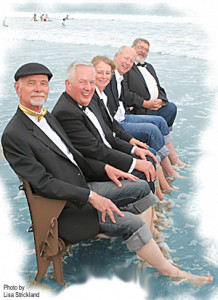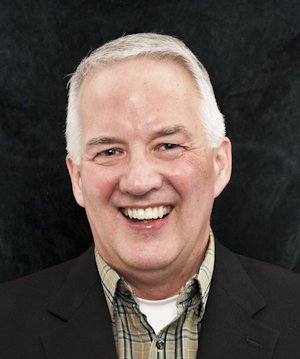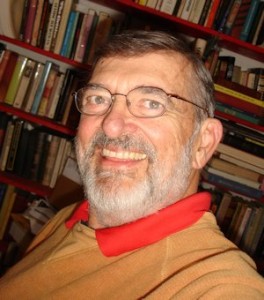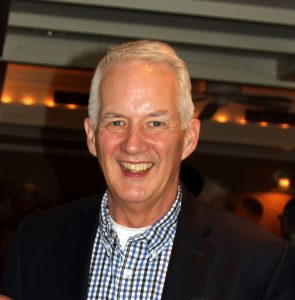SanDiegoStory.com Writers Present Bravos and Boos For 2014
Judging from the reaction of SanDiegoStory.com’s team of reviewers, 2014 was a mixed year for the arts in San Diego. While there was plenty to savor, there was also plenty to criticize. We’ll wrap up 2014 with our writers’ “bravos and boos” for the year.

Founding members of Critics LLC (from left) Ken Herman, Bill Eadie, Kris Eitland, Mark Burgess, Welton Jones
Our top story attracted international attention. It began as a huge “boo” and ended in a tentative-but-full-of-pride “bravo.”
That story, of the proposed closure and ultimate resurrection of the San Diego Opera, proved to be an object lesson in the power of a community to say “no,” “hell, no,” and “no way” when the continued existence of a major arts institution is in question. The story also serves as a reminder that artistic transitions are never easy and that an institution’s board becomes key to the continued success of the institution that board serves. For the Opera, it took a courageous remnant of a board whose majority had been convinced to take the opposite course to demonstrate that not only could the Opera continue, albeit in a different form, but that the funders didn’t need to be limited to a small group of wealthy individuals.
The other big story went relatively unnoticed. In 2014, San Diego emerged on the national stage as a major theatre town. Now, many San Diegans thought they already knew that, but it took the Theatre Communications Group, the New York-based organization representing the variety of U. S. theatre companies, to meet in San Diego for the first time and validate nationally what was well-known locally.
Special events held sway in 2014, from a second, even better, year for the San Diego International Fringe Festival, to the very successful Carlsbad Music Festival, to a disappointing year for SummerFest. Arts seemed to draw local attention when a group did something outlandish (witness: Lamb’s Players Theatre breaking the world record for longest theatrical performance). Even a local university got into the act, as San Diego State’s theatre and music programs combined to stage a massive concert version of Les Misérables, drawing crowds to campus (disclosure: Bill Eadie is a member of the faculty at San Diego State University).
The “even better” Fringe Festival provided an infusion of energy and creativity into the local dance scene, including “Victor Charlie,” a theatre/dance piece from The Movement Initiative that Janice Steinberg called “jaw-droppingly good.”
SanDiegoStory.com also welcomed the return of Kraig Cavanaugh, who brought his deep knowledge of the local, regional, national, and international art scene to his reviews of local exhibitions.
That said, let’s hear from our reviewers. Each one was asked to identify “bravos” and “boos” for 2014, and their responses provide interesting insights into the variety of thought that makes SanDiegoStory.com a leader in outstanding arts writing. As music is this year’s top story, we’ll start with music reviewer Ken Herman.
MUSIC
Ken Herman
Bravos
1) San Diego Opera’s March production of Verdi’s A Masked Ball, one of the best operas the company has mounted in the last decade, featured a superb international cast (tenor Piotr Beczala, soprano Krassimira Stoyanova and mezzo Stephanie Blythe), fleet direction, and displayed all the emotional fervor for which this stellar Verdi work is noted. This fall, I saw San Francisco Opera’s A Masked Ball with the same sets and costumes, and their production—with a much weaker cast—did not even come close to San Diego’s success.
2) On the heels of A Masked Ball, San Diego Opera presented Verdi’s Requiem in concert at Civic Theatre, a thrilling, deeply felt account that featured bass Ferruccio Furlanetto and the three Masked Ball leads as the solo quartet. Under the smart direction of the young Italian conductor Massimo Zanetti, the combined Opera Chorus and San Diego Master Chorale provided power and depth to the Requiem.
3) A huge bravo to the coalition of musicians, opera supporters, opera staff, union members, and civic leaders who saved San Diego Opera in May from its abruptly concocted demise (see Boo #1: Ian D. Campbell). Leading the charge to save the company was Carol Lazier—now President of the reconstituted Opera Board of Directors—who put her money where her heart was to the tune of $1,000,000. She inspired an internet-based crowd funding effort that brought the $2.1 million in a month’s time, enough cash to persuade the Board to rescind its closure vote.
4) Opera NEO, a summer festival located on the Point Loma Nazarene University campus, staged a spirited and dramatically powerful production of Handel’s early opera Aggripina in August. Although the cast members were younger, even aspiring opera singers, most sang with surprising command, and director Peter Kozma’s updated ancient tale worked effectively as a contemporary political saga for our own media-saturated era.
5) Although the San Diego Symphony has a modest record fostering contemporary music, they scored in December with their commission of David Bruce’s Violin Concerto “Fragile Light,” beautifully executed by soloist Gil Shaham and conducted attentively by Music Director Jahja Ling. An atmospheric, meditative work with a sophisticated minimalist orchestral component, “Fragile Light” eschewed vapid pyrotechnics but offered significant emotional reward.
6) For the last 10 years, Carlsbad Music Festival Director Matt McBane has presented a September weekend of exciting and ecletic new music that simply takes over the village of Carlsbad. This September, McBane hosted in residence American composer David Lang, whose substantial works suffused the festival. But the Bravo belongs to McBane, who not only organized the festival but played a program of his own violin music and composed works for ensembles featured during the festival.
7) Ruben Valenzuela’s Bach Collegium San Diego maintains an exceptionally high performance level throughout each season, so picking one program to honor was challenging. However, the Bach Collegium’s J. S. Bach B Minor Mass in April proved so transcendent and vibrantly executed that I am eager to hold it above the ensemble’s other fine offerings. Valenzuela used the best scholarly insights and accepted performance practices to make this Bach Mass come alive, rousing the emotions and touching the hearts of the audience.
8) Eminent Japanese pianist Mitsuko Uchida finally made her San Diego debut this March, and her probing solo recital of Beethoven and Schubert on the La Jolla Music Society’s Frieman Family Piano Series proved nothing less than a master class on Classical style filled with a lifetime of insight and avid appreciation.
9) For some time the San Diego Master Chorale has needed a better vision and some serious musical renovation. From the robust yet stylish Haydn Mass in Time of War the Chorale performed with the San Diego Symphony in November, it appears new Director John Russell (he assumed that post in August) is bringing these changes about in relatively short order.
10) I knew nothing about the Danish String Quartet before they gave their San Diego debut concert—exciting and scrupulously fine-tuned—for UCSD’s ArtPower in February. After playing the same repertory in New York City a few weeks later, the New York Times could barely contain its enthusiasm for this ensemble of young Scandinavian musicians.
Boos
1) This spring, Ian D. Campbell, San Diego Opera’s former General & Artistic Director, attempted to shut down and liquidate the company to leave town with as much booty as he could claim from the debt-free company with valuable tangible assets. Earlier he had ignored wise advice from Opera America to revise the company’s programming and build community outreach along the lines followed by successful North American opera companies. Instead, Ian significantly inflated his own salary and that of his (then) wife Ann Spira Campbell, who had risen to the post of second in command at SDO under Ian’s oversight. The Campbells’ tactics to shutter the company failed, but Carol Lazier (see Bravo #3) and saner (and less greedy!) SDO staffers applied Opera America’s advice to company operations and are about to open SDO’s 50th anniversary season in January, 2015.
2) Although I have been a longtime fan of La Jolla Music Society’s annual SummerFest, the unimaginative programming and some performances of SummerFest 2014 proved a serious disappointment. The opening weekend offered Vivaldi’s Four Seasons, portions of Tchaikovsky’s Nutcracker score and Mozart’s Eine Kleine Nachtmusik, the overplayed chestnuts music appreciation teachers hope will persuade students with no classical music experience will find appealing. And any music with the slightest edge was sequestered in one evening’s program. Two seasons ago, SummerFest offered Tan Dun’s breath-taking Water Passion. SummerFest 2014 adventurous foray gave us a song cycle by film composer Howard Shore. Can someone get SummerFest back in gear and off of cruise control?
3) Organist Anthony Newman provided sloppy and ill-prepared accompaniments to trumpet virtuosa Alison Balsom at SummerFest 2014. It was a wonder that Balsom survived Newman’s treachery. Fortunately, on the program’s second half she was accompanied by pianist Orion Weiss, whose skill and sensitivity almost made up for Newman’s ineptitude.
4) San Diego Opera’s 2014 season got off to a lame start with a half-hearted production of Leoncavallo’s one-act Pagliacci. Had the opera been a vocal and dramatic success, we might have forgiven Ian D. Campbell for short-changing the patrons with only half an evening’s entertainment. Traditionally, major companies present a pair of one-acts to expose their audiences to this specialized repertory. SDO’s lead singers in this Pagliacci evidenced little chemistry, and stage director Andrew Sinclair’s tweaks to the opera’s shabby plot did not help in the slightest.
5) Irish pianist Barry Douglas sullied the reputation of La Jolla Music Society’s Frieman Piano Series with his careless and unrevealing performance of Schubert and Brahms in May at La Jolla’s Sherwood Auditorium. Rarely have I seen a performer so eager to finish a program and escape the hall. It was no surprise that he came back for neither a second bow nor an encore.

Kraig Cavanaugh
ART
Kraig Cavanaugh
The year 2014 had many artistic mistakes, near hits, and sterling grand slam home runs. Artists who displayed disappointments were Joseph Huppert and Rashell George. Huppert and George were included in Quint Gallery’s summer exhibition Horizon and got lost trying to follow rather than lead due in large part to their mimicry of other more famous artists’ works. Huppert’s small minimalistic, rectilinear shaped images made from electrical tape became tiny affectations of minimalism rather than making real statements. George’s cut and pasted images of landscape elements became insubstantial and wan stand-ins for the more famous artworks of John Baldessari.
A “near hit” was Ricardo Xavier’s meticulous painted floral paintings in his solo exhibition titled Kinetic Contrasts at La Jolla’s R.B. Stevenson Gallery. While moving closer to being complex works, most of the paintings in Xavier’s exhibition were stifled by their mirrored bilateral symmetry. Even when Xavier created good spatial effects, the overall lack of complexity in basic design in the majority his paintings made the meticulous silkscreen paintings on display feel checked and restricted.
Artists who made terrific impressions were Jessica McCambly and Heather Rasmussen, who were also included in the Quint Gallery Horizon summer exhibition. McCambly’s small painted images that resembled painful diamond bedazzled anuses about to pinch splendid loaves of amethyst, aquamarine, or citrine gemstones were genuinely memorable—looking exquisitely painful yet beautiful. Heather Rasmussen’s well-crafted photographs were complex and luxurious to view and also had unexpected irony to make them well rounded laugh-out-loud viewing pleasures.
One “almost hit” was the La Jolla venue of the Museum of Contemporary Art San Diego’s Treasures of The Tamayo Museum, Mexico City. While the works on exhibition were of great quality, the museum’s cramped La Jolla venue made it seem as if one had viewed only half of an exhibition.
An exquisite exhibition this year (unfortunately not reviewed by this critic) was the Timken Museum of Art’s tiny jewel of an exhibit El Lissitzky: Futurist Portfolios that featured two print portfolios created by the famed Russian Revolution era artist and designer. One portfolio consisted of El Lissitzky’s costume renditions of Kazimir Malevich’s opera, Victory over the Sun. The other portfolio consisted of axonometric renderings of El Lissitzsky’s room installations called PROUNs. The exhibition was set within an artistic recreation of a PROUN installation. The effect of viewing El Lissitzky’s axonometric renderings within a room of a similar interpretive design allowed for an exceptional ability to comprehend the significant artistic contributions by the Russian artist.
Another great brain teaser of art exhibition was the solo exhibition Speaking Otherwise by Alison Wiese at La Jolla’s Athenaeum Music & Arts Library. While many viewers seemed flummoxed by Wiese’s grand sculpture Shibboleth (2014), the artwork was both extraordinarily complex and very well thought out in its execution of the subject matter.
The “grand slam” of 2014 is the ongoing Gauguin to Warhol: 20th Century Icons from the Albright-Knox Art Gallery at the San Diego Museum of Art in Balboa Park (on view through 27 January 2015). The exhibit includes some of the most famous paintings by the most famous artists of the late 19th & 20th-centuries: Gauguin, van Gogh, Salvador Dalí, Arshille Gorky, Picasso, Willem de Kooning, Jackson Pollock, Frida Kahlo, and even more famous names than can be mentioned. The exhibit has some of the most famous, jaw-dropping paintings and exquisite examples in art history from Abstract Expressionism, Futurism, and Surrealism through Minimalism and Pop Art. Gauguin to Warhol… has everything going for it: a vast amount of great artworks by great artists. It is (and will be remembered as) one of the very best exhibitions EVER presented in San Diego!
DANCE/THEATRE
Kris Eitland
I was asked to limit my top choices to 10, which is an impossible task, so I cheated. I squeezed in a few more by combining those seen at festivals, mixed bill productions, and multiple works from the same producer.
Bravos
Giselle. California Ballet launched its 47th season with the ghostly ballet about an ordinary girl who dies of a broken heart when she discovers her lover is engaged to another woman. As Giselle, the feathery Ana da Costa transformed from love-struck sweetness to madness and jerky death. The Wilis, angry spirits of spurned brides, tried to dance her lover to death, but she rescued him. Tall and gallant, Trystan Merrick gave da Costa superb support as Albrecht. She seemed to levitate in lifts and his speed and execution were exceptional. Along with da Costa and Merrick, another bravo goes to Denise Dabrowski, company regisseur, for the striking balance between pretty and spooky, and drawing some of the best technique to come from this company in years.
Awáa. The gurgling creation story by Aszure Barton & Artists, presented by ArtPower! at UC San Diego’s Mandeville. For more than an hour in February, we were submerged and sent adrift down a dreamy river led by the most gifted and flexible dancers I’d seen in years. Barton’s Awáa has the quality of reeds pushed and twisted by currents. There’s a sense of time being slowed down, as when floating in water, in a peaceful weightless way. Along with two commissioned scores, bubbly sounds beckoned visual bubbles in the form of red and white balloons. We were left with many curious ideas and symbols. While my review couldn’t cover all of the elements in this dynamic show, it did garner the First Place Excellence in Journalism award for reviews this year from the San Diego Press Club.
City Ballet of San Diego’s Ballet & Beyond, offered two programs with work by four choreographers that drew both ballet and modern dance audiences to the glorious Spreckels Theatre. Along with works by City Ballet choreographer Elizabeth Wistrich and Geoff Gonzalez, San Diego Dance Theatre and Malashock Dance, two of the top contemporary companies brought outstanding works (Jean Isaacs’ “O Magnum Mysterium” and John Malashock’s “Great Day.” Honorable mention goes to City’s Swan Lake with ballerina Ana da Costa, and Balanchine Masterworks that interprets the master’s work so admirably.
Jeffrey Scott Parsons in San Diego Musical Theatre’s production of Irving Berlin’s White Christmas . Even with Berlin’s delightful songs and a trunk full of vintage costumes, the old-style musical would have been a yawner without the dancing style of Parsons. Partnering with Tro Shaw, he injected energy to a tired storyline. His dialogue was quick, and dancing energized. In the expansive tap number “I Love the Piano,” Parsons wowed the crowd with tour jetes, solid syncopation, and straight up leaps. Bravo to choreographer Lisa Hopkins, and don’t forget the two squeaky Oxydol girls, Rita and Rhoda. Bravos to April Jo Henry and Sirii Hafso for their flirty banter that gave the old show a dose of life saving comedy.
Trolley Dances #16. Jean Isaacs’ dance adventure is a balance of artistry and logistics that transports wide-eyed travelers to view site specific dance in unexpected places. There is pleasure in watching dance where it is not supposed to be. For two weekends, Isaacs’ San Diego Dance Theater and four choreographers (Michael Mizerany, Terry Wilson, Blythe Barton, Grace Shinhae Jun) presented dances along the tracks from City College to Market Creek. Instead of a stage, audiences discovered dancers in odd places, such as pressed against a stairwell and bouncing off metal girders, which changes the way one views those places and surrounding communities. Bravo to the dancers and 28 performances over two weekends.
San Diego International Fringe Festival. Tin Shed Theatre’s Dr. Frankenstein’s Travelling Freakshow, a brilliant combination of physical theater and madcap clowning culminated with unexpected punch. The troupe crossed the pond from Wales with boxes of odd props and puppets, yet four remarkable performers captured the heart of Mary Shelley’s book – life is cruel and everyone deserves love and a companion. More excellent programs at the festival deserve mention Perception and Perseverance drew steady crowds with its steamy choreography by local dance makers Blythe Barton and Zaquia Mahler Salinas; as did a revival of Weill and Brecht’s Seven Deadly Sins, performed by Bodhi Tree Concerts. Spare and darkly humorous, actors sang like a Greek chorus to fine piano in this wonderfully strange and worthwhile premiere.
Justin Hudnall in Damaged Goods. The collaboration between Justin Hudnall of the poet therapy group So Say We All and San Diego Dance Theatre started out with the energy of a salon inside the White Box. But then Hudnall lamented about PTSD, psychotherapy, and sexual troubles, while interacting with dancers. Without a hitch he flung his coat onto their heads as if they were furniture. A confident mover, his rant grew more intense and scary as dancers grabbed and twisted his torso. It was rare to observe such strong chemistry between verse and dance, and annoying as hell that the show had a short run.
Sean Murray and Jamie Torcellini in Moonlight’s Spamalot. Moonlight Amphitheater is the best kept secret in town, but why? You won’t find more remarkable theater productions unless you travel to New York, and then you’d miss the stellar performances by the silvery Sean Murray, as the regal buffoon King Arthur, and Jamie Torcellini , as his clip-clopping sidekick Patsy. Together they brought golden timing to gags about the plague, fish slapping, and coconut galloping. Honorable mention also goes to Moonlight’s Catch Me if You Can that globetrots with conman Frank Abagnale, and boasts satire, flashy dance, and the glitz of a 1960s TV show and Mary Poppins, starring Jessica Bernard as the quirkiest nanny to ever fly an umbrella.
The Old Globe’s Bright Star gave us powerful songs overflowing with rich imagery. The actors sang with easy restraint, and we could hear every tender word. Musical director Rob Berman conducted from his piano on stage, which made bluegrass instruments in Steve Martin and song maker Edie Brickell’s new show sound like an orchestra.
The Foreigner, presented by Lamb’s Players Theatre drew on ancient themes about love and deceit, and there was a bounty of funny, rapid-fire dialogue. It was most rewarding to watch the weakling Charlie, played by Geno Carr, transform and find his backbone. In the end, outrageous humor exposed the absurdity of prejudice, and that felt great.
The Book of Mormon. Irreverent, vulgar, and outlandishly funny, the spoof pokes fun at those guys in white short sleeved shirts, skewers the Mormon Creation story, and reveals doubts about faith in general. The production at the Civic Auditorium held enough Broadway value to make it worth the price.
Boos
Both The Book of Mormon and Wicked get blaring boos for rotten sound in the Civic Barn Auditorium. Too loud and over-modulated, we missed some of the key punch lines and voices got swallowed up by orchestras. There’s no reason to crank the volume to 11. Wicked was worse. Songs with more than two voices were a muddy mess, and they grew to sonic assault that hurt and ruined what should have been a wickedly good show.
John Nettles, director of the City Ballet Orchestra, gets an honorable mention for conducting live music for classics such as The Nutcracker, but boo for his torturous autobiographical opera- A Life According to Me filled with dated pop songs; it had no place in the otherwise rewarding program Ballet & Beyond.
Boo to Courtesan Café presented at Les Girls Theater, a strip club used as one of the Off Fringe sites in the Fringe Festival. As in previous productions, the ArtBurlesque troupe relied on achingly bad butoh and improvisation, too many non-dancers, and a vague and useless stripper plot. Another missed opportunity to present truly hot burlesque.
Boo to Moonlight Stage Productions for presenting Nunsense at the AVO Playhouse for its winter season. The dated musical started out as a marketing scheme for snarky nun greeting cards in the 80s and needs to stay there. The hellish show with nuns behaving like children and getting high on amyl nitrate poppers was as stale as a communion cracker and an embarrassment for the determined actors.
THEATRE
Welton Jones
Many Boos this year. So, first the Bravi:
Bright Star would be a proud ornament for any season of any playhouse but coming, as it did to the Old Globe this year, in an era of musical clunk and confusion just reinforces the Globe’s importance to the American theatre. Edie Brickell and Steve Martin’s sweet, flavorful bluegrass yarn, with its piquant literary overlay, may enchant generations or die without a trace, but it made my year.
(The Hunchback of Notre Dame, after it’s sufficiently massaged with Disney money, should be profitable on Broadway, thanks in good part to Alan Menken’s music. But a bravo for its La Jolla Playhouse version? Probably not.)
Neither The Book of Mormon nor Kinky Boots were exactly what one might have expected but both were rich, brightly polished road versions of Broadway hits welcome at the Civic Theatre. It’s easy to make fun of Mormons but much harder to cut them some slack, as Trey Parker and Matt Stone have done amidst all the devastating satire of clueless missionaries in Africa. And Boots turned out to be a Harvey Fierstein-Cyndi Lauper paean to capitalism, wherein in a failing family show factory finds new markets among drag queens rich in flamboyant finales.
The Globe’s Two Gentlemen of Verona was the most memorable Shakespeare I encountered this year, a bright, bouncy tab version of a very insignificant comedy, notable for its sleek supporting cast, its elegant look and sound and the savoir-faire of director Mark Lamos.
The Orphan of Zhao brought to the La Jolla Playhouse stage a juicy blend of virtuoso stagecraft, ethnic nuance, exotic flavors and ethical red meat based on an ancient Chinese fable and staged with masterful vision and control by Carey Perloff.
Moxie Theatre helped me comprehend the baroque greed of the Enron Corporation’s messy demise with a careen through Lucy Prebble’s tragicomedy Enron, savagely cynical in Jennifer Eve Thorn’s quickstep staging. And, for Christmas, Diversionary Theatre dusted off Presson Allen’s version of Truman Capote in the form of Tru, a one-person extravaganza featuring, of all people, Todd Blakesley, for decades a protean man of the theatre hereabouts but not the first guy you’d think of to play a poisonous elf.
Speaking of Blakesley, he was prominent and tireless as a principal organizer, with Kevin Charles Patterson, of the year’s most extended stretch of theatrical fun, the San Diego International Fringe Festival. It was a week of total lagniappe spread around downtown and environs with memories mostly fond: Beau and Aero, Lady Grew, Jon Bennett…
The boos take up less space:
Ian Campbell, who decided to bail out suddenly on the San Diego Opera taking our 49-year-old company into oblivion with him. Not so fast, said the city.
Ether Dome, an ill-advised theatrical project at La Jolla Playhouse that hurt like a broken tooth.
Award shows, just too damned many of them and too many winners in each. As the Dodo said to Alice in Wonderland, “EVERYBODY has won and all must have prizes.”
And no real party for the centennial of the Panama-Pacific Exposition, which gave the city the buildings and gardens of Balboa Park? For shame!
THEATRE
David Dixon
Bravos
The School for Lies. A comedy written entirely in verse was frequently hilarious thanks to David Ives’ cheeky script. The director of the North Coast Repertory Theatre’s production, Andrew Paul, turned what could have been a dull experiment into a wild romp. Performers Richard Baird and Jessica John made for an unusually appealing pair in the full-length homage to Moliere.
Crumbs From the Table of Joy. Moxie Theatre’s Artistic Director Delicia Turner Sonnenberg staged an empathetic and often comical examination of an African American family living in Brooklyn in the 1950s. This coming of age drama felt achingly honest as well as hopeful. Pulitzer Prize winning writer Lynn Nottage’s stylized script resulted in absorbing viewing for the audience.
Spring Awakening. As expected, Cygnet Theatre Artistic Director Sean Murray was able to retain the high energy of the highly successful rock musical. For all the frank depictions of sex and teenage angst, there were plenty of emotional sequences throughout the piece. With a game ensemble, Murray found just the right balance between tragedy and unsentimental uplift.
Vanya and Sonia and Masha and Spike. Jessica Stone directed a hysterically funny interpretation of Christopher Durang’s comedy. Sadly, the San Diego premiere was bittersweet since the director of the original Broadway production, The Old Globe Associate Artist, Nicholas Martin, passed away shortly before the opening. Martin would have been proud of Stone’s take on the material.
Next to Normal. Bets Malone gave a startlingly fierce and compassionate performance in San Diego Musical Theatre’s version of the Tony and Pulitzer Prize winning rock musical. She bravely was able to humanize the bipolar suffering protagonist, Diana Goodman. Her multidimensional work resulted in a sometimes shattering as well as a consistently moving event.
Boos
Chasing the Song. For the La Jolla Playhouse’s Page to Stage program, the artistic team behind Memphis tried to tell an epic tale about music in the 1960s. Although many of the original tunes were instantly hummable, the flawed plot needs a lot of work before it heads to the Great White Way.
Maple and Vine. Cygnet Theatre director Igor Goldin attempted to make Jordan Harrison’s bleak satire a thought provoking commentary on the 1950s. Unfortunately, Harrison’s script started off slow and crammed in too much material during Act II. At least Goldin has moved on to direct several successful projects after the problematic comic drama closed.
Bethany. The marketing of Bethany at The Old Globe referenced the pitch black drama as a dark comedy. In spite of instances of comical relief, the haunting play was quite disturbing and featured a horrific climax. As good as Bethany was, labeling the theatrical experience as a different genre was false advertising.

Martin Jones Westlin
THEATRE
Martin Jones Westlin
Bravos
Himself and Orson. San Diego actor Richard Baird might not like them, but he at least concedes that the inevitable comparisons between him and Orson Welles can’t help but exist (it wasn’t all that many years ago, in fact, that Baird assumed the iconic Welles’ role as astronomer Richard Pearson in a staged reading of The War of the Worlds). The parallels were rife as Baird co-founded San Diego’s Poor Players company, with its edgy, modernistic take on the works of Shakespeare – and after stints in Chicago, Arizona and Oregon, Baird’s back is San Diego with his New Fortune Theatre Company, having staged Henry V last fall. Baird once said that he studies performance art the way other guys read baseball stats – and that brand of obsession shows in every performance he undertakes. His turn as the title character intent on taking France during The Hundred Years War was no exception. San Diego is delighted to have him and his excitingly reconstituted venture. If Welles weren’t dead, he’d be watchin’ his back.
A Good Show Made So Much Better. San Diego’s Comic-Con is the biggest popular arts convention in the history of the universe, and it’s only appropriate that local theater serve up some of its own escapist twists and turns every summer accordingly. Such was the case with last July’s BLKBOX offering of Geeks! The Musical!, a frothy PsyPhi Productions piece about art, love, self-authenticity, reconciliation and Batman comic book No. 92. It centers on Kerry (Sarah LeClair), one of the only women in attendance at Comic-Con one year – playing opposite her was James P. Darvas as Emerson, whose wholesale snobbery is exceeded only by his gayness. Emerson was perfect in Darvas’ hands – the actor touched each character’s life with nuances particular to that character, and he turned Emerson’s histrionics on a dime amid his come-uppance at the end (a very difficult thing to do). I haven’t seen Darvas before or since, but I sure hope I do again somewhere.
Everything It Had. Cats, Broadway’s longest-running musical, is about the only stageworthy thing composer Andrew Lloyd Webber has set to music before or since Jesus Christ Superstar – this criminally overrated figure somehow managed to stop chasing his musical tail long enough to pen a heartfelt story of a tribe of cats called the Jellicles, who decide which cat will ascend to the Heavenside Layer and come back to a new life. Webber couldn’t have done it without the help of poet T.S. Eliot, on whose anthology Old Possum’s Book of Practical Cats the play is based – the result is lots of comprehensible music, with one piece leading logistically to the next. It has its jangly subtext, but director James Vasquez found ways around the faulty logistics, and his helmsmanship fueled last spring’s topnotch tour-de-force by San Diego Musical Theatre. Cats is not a perfect play, but it’s pretty damn good, and I must say SDMT gave it everything it had.
Saving the Best for Last. If Lamb’s Players Theatre’s Les Misérables wasn’t a high-water mark for San Diego performance, then no such mark exists. We’ve had our stellar turns before, some of them quite recent (Cygnet Theatre Company’s gritty and gigantic Sweeney Todd: The Barber of Fleet Street, from 2010; MOXIE Theatre’s superbly nuanced A Raisin in the Sun, done in 2012) – but Les Miz had Lamb’s artistic director Robert Smyth at the helm, and he’s a positively diabolical tactician. The sprawling musical on misery and injustice following the French Revolution somehow became an intimate parable of human resolve on the tiny Lamb’s stage, with outstanding performances all around from the all-local cast – the show, which opened July 25, was extended about 412 times, and even then, nobody could get enough. Absolutely, colossally wonderful.
Boos
Most Disappointing Musical in the History of Everything. I was taking two colleagues back to their respective parking places following Once, a summer entry from Broadway/San Diego, and nearly didn’t live to talk about it – such was my errant driving (and our riotous laughter) after the horror that was this show. Once is a 2011 musical about the unlikely meeting between an Irish music hopeful and a perplexed Czech immigrant (who also happens to be married); the short version is that they don’t get together in the end (which we figured out pages ago), and their breakup is supposed to be all sad and weepy and stuff. But Enda Walsh’s story moves from plot point to plot point on a dime, without so much as a nod to the indispensable cultural contributions that both characters’ nations represent. The result is a boy-loses-girl sketch whose pre-show open bar and musicians within the cast amount to no more than an expensive gimmick. For a play that inexplicably won eight of 11 Tony Awards, Once wasn’t nearly enough.
How Could Diversionary Stoop So Low? The case of Nathan Leopold and Richard Loeb transfixed the country when it unfolded in 1924 – the two University of Chicago law students decided they would rape and kill 14-year-old Robert Franks for the fun of it, all the while seeking to commit the perfect crime. Arguably, the country may not know that the two were gay lovers whose exceptional intelligence later fueled their argument that they were above the law. That seems to be the point – and the only point – to Diversionary Theatre’s Thrill Me, a bioplay the company staged for about three seconds last spring. The Bret Young-directed piece had absolutely no sense of subtext, such as exposition about how the two ever got together, what environmental factors may have fueled their sociopathy, or how they fared in prison – the Latin-flavored beats to the music are the only indication that the show sees its own light of day. The result: an absolute lack of empathy for the two protagonists, and thus an indifference to their sexual orientation. Somehow, I don’t think that was supposed to be the point.
The Family That Never Was. At this time of year, holiday shows are a dime a dozen – but good ones, such as Cygnet Theatre’s defunct, radio-inspired It’s a Wonderful Life, set the season on its ear, leaving us anticipating an equally fulfilling follow-up. Accordingly, Cygnet is staging A Christmas Carol for the first time since 2005, this one with an adaptation by director Sean Murray and replete with a thoroughly wrongheaded take on Charles Dickens’ classic story. The problem lies chiefly in the absence of Ebenezer Scrooge’s glad-handing nephew, Fred, who’s absolutely essential to the story in that he represents so much of the subtext about Ebenezer’s family. Without him, it’s that much tougher to experience Eb’s alienation from everyone around him and doubly hard to reconcile Eb’s epiphany. Dialogue for its own sake further muddles the piece, and the use of puppetry and Foley effects looks all the more gimmicky alongside. There are many wonderful aspects to this piece, but without much, much more subtext, Ebenezer Scrooge may as well sit this one out, somewhere on a tropical island.
THEATRE
Bill Eadie
Bravo to the La Jolla Playhouse and the San Diego REPertory Theatre, who collaborated to create the most exciting theatre experience imaginable for delegates to the Theatre Communications Group conference: a site-specific staging of Herbert Siguenza’s take on Shakespeare’s two-part Henry IV, El Henry. If you knew Mr. Siguenza’s work with “Culture Clash,” the themes of El Henry wouldn’t be a surprise, but the nice part about director Sam Woodhouse’s production was how well it fit the East Village site in which it was staged. Virtually everything worked, including Jennifer Brawn Gittings’ costumes, Bruno Louchouarn’s original music and sound design that blended effortlessly with the sounds surrounding the 15th Avenue venue, and the inclusion of the Valdez brothers, sons of Chicano theatre icon Luis Valdez, in leading roles.
And boo to the theatre companies in town who made either misguided efforts (North Coast Rep’s “world premiere” of a 40-year-old play, The Old Globe’s promotion of its only-ok production of Christopher Durang’s Vanya and Sonia and Masha and Spike and its early previews of Othello, featuring an overly-domineering performance by Richard Thomas as Iago) or, worse, ignored the conference altogether.
Bravo to the boards of several arts organizations that successfully made leadership transitions in this past year. Particularly difficult were organizations where the founder or a long-term leader was departing (Mainly Mozart, Mo’olelo Performing Arts, San Diego Opera). Thanks to excellent leadership, all three of these organizations made successful transitions (though, boo to the Opera board, most of whose members allowed their long-term leader to paint such a pessimistic picture of the future that the board initially voted to close the organization instead of implementing a plan to continue in a revised format). Bravo, too, to boards such as the one for Diversionary Theatre, whose members stepped forward to manage the organization during the year-long transition to new leadership (disclosure: Mark Burgess, SanDiegoStory.com’s managing principal, is a member of the Mainly Mozart board; Bill Eadie served as a community member of Diversionary’s search committee for its new Executive Artistic Director).
The San Diego Symphony will soon be searching for a new music director, and I hope that its board will manage a transition process that is at least as successful as the ones that occurred in 2014.
Bravo as well to companies that have forged new directions following leadership changes. Steve Glaudini, the new artistic director at Moonlight Stage Productions, helmed the most successful summer season of musicals in many a year. He’s also announced the elimination of the winter season, beginning in 2016, in favor of using the company’s amphitheater space year-round, not just in the summer. At the Old Globe, artistic director Barry Edelstein has begun to make his mark by eliminating the repertory concept for the summer Shakespeare productions, a move that allows the Globe to attract strong talent for shorter runs. Mr. Edelstein has also programmed the White Theatre to present voices of playwrights he thinks local audiences should hear. Even if the plays presented have not always been successful the voices of their creators have been consistently interesting.
Bravo to ion Theatre for taking a risk with its season and presenting a series of new plays in workshop form, one of which will be developed for presentation off-Broadway this coming summer. But, boo to ion for keeping critics from writing about these workshop productions. Yes, companies such as the La Jolla Playhouse have series that present new plays and don’t allow reviews. But, these no-review productions take up a relatively small amount of the company’s time. Ion is taking the lion’s share of its current season for the selection process of its New York debut, and reviewers should be able to provide progress reports on that process.
Bravo to Lamb’s Players Theatre, which rebounded from the loss of its resident company to produce a production of Les Misérables that was not only the best production on San Diego stages in this past year but was also a hit with audiences as well as critics, prompting multiple extensions and extended paychecks for a large and hard-working cast and crew.
And, bravo to the loyal readers of SanDiegoStory.com. With another set of victories at the 2014 San Diego Press Club awards we’re confident you find the coverage we provide to be provocative, well-considered, and well-written. Our authors are pleased to have established SanDiegoStory.com as the site for local arts coverage, and we thank you another good year.

Mark Burgess
AND NOW, A WORD FROM OUR PUBLISHER
Mark Burgess
Oscar Wilde said it really well:
“The critic will certainly be an interpreter, but he will not treat Art as a riddling Sphinx, whose shallow secret may be guessed and revealed by one whose feet are wounded and who knows not his name. Rather, he will look upon Art as a goddess whose mystery it is his province to intensify, and whose majesty his privilege to make more marvelous in the eyes of men.”
― Oscar Wilde, The Critic as Artist
The writers here at Critics LLC, publisher of SanDiegoStory.com, certainly seek to fulfill Wilde’s goal. It is with a love of Art and a high regard for the artists that each approaches an assignment. When disappointment in a performance or a showing results in a “boo,” it is given with a heavy heart and a gleaming eye on what might have been done, what the writer sees in the possibilities the artist possesses – emphasis on the present tense.
San Diego’s big bang of artists, arts organizations and splendid venues has birthed a daunting universe to explore – even limiting our scope to professional presentations, leaving students to learn and grow before they are held to professional standards. Each month, lying on their backs gazing at the vault of performances and exhibitions scheduled, the writers build their itineraries knowing that for each hour of performance witnessed, they will spend at least two or three hours researching and writing and editing and editing some more until it’s time to press the PUBLISH button and add their thoughts to the constellation of work. Unlike the artists whose performance they describe, that moment – usually late at night – is not followed by applause, or even boos – just silence. The moment passes, they load the front end of the web site and look one more time at the piece as you will read it.
One measure cited for discerning what is art and what is not is whether it made the observer feel anything, a reaction. Every theatre goer, concert attendee, dance observer or stroller of a gallery usually has some reaction to the art if they paid the least attention. Listen as you leave a venue, though, and what you hear is talk of getting the car and “I told you to turn your phone off”. Sometimes you hear “that was nice.”
The only automatic and observable critique is whether a continuing show builds larger audiences over its run or fades away, unavailable as feedback to one time showings. As our esteemed Welton Jones oft reminds us: every live performance is a first and only. Unlike a movie, the next night’s performance – even of the same piece – is not the same.
The Critic gives voice to what those ticket buyers may be feeling or thinking as they sit listening; stand observing; or as they grow quiet on the ride home afterward. Backed by education and long experience, our team at SanDiegoStory.com adds depth and nuance to their observations or feelings in a way that can extend a good performance for the reader or serve as outlet for exhaling a bad one.
Artist, writer, therapist, Pat B. Allen wrote that “art is a way of knowing what it is we actually believe.” Once discovered, such realizations beg for discussion. We look forward to presenting our views on the performances of 2015 to you. We hope you’ll stop in often, join in the conversation and recommend us to your friends and coworkers.

In addition to reviewing theatre for San Diego Story, Bill also reviews for TalkinBroadway.com. He is a member of the San Diego Theatre Critics Circle and the American Theatre Critics Association. Bill is an emeritus professor in the School of Journalism and Media Studies at San Diego State University.





